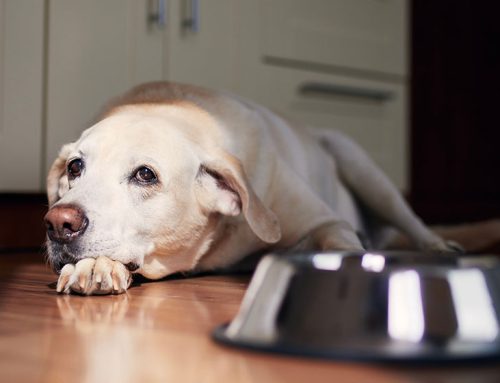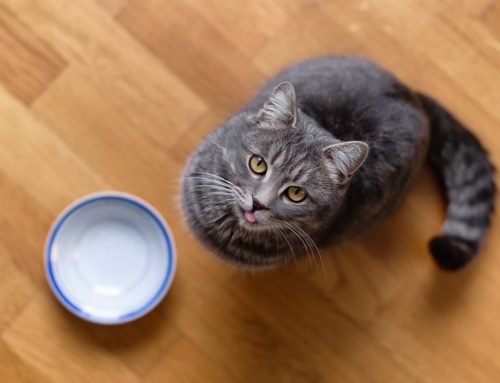Pet obesity and weight management are enormous topics—pun intended—and pet owners can easily feel overwhelmed by all the information surrounding diet, exercise, and what a “healthy weight” pet means. To help you understand the high cost of a few extra pounds, Village Veterinary Hospital has broken down this big issue by the numbers.
56 million cats and 50 million dogs are overweight or obese
According to the Association for Pet Obesity Prevention, this is the estimated number of obese and overweight cats and dogs in the Unted States in 2018, which shakes out as well over half the national pet population—59.5% of cats and 55.8% of dogs. Although more recent numbers have plateaued, the 2021 survey revealed a startling gap—only 39% of dog owners and 45% of cat owners recognized their pet as overweight or obese.
Pets are classified as overweight or obese if they weigh 10% to 20% more than their ideal weight
Excess fat (i.e., adipose) tissue creates an inflammatory environment in the body, and leads to pain, widespread cell and tissue damage, impaired immune function, and—over time—chronic disease. Overweight and obese pets are at an increased risk for life-altering conditions, including:
- Cancer
- Arthritis
- Orthopedic injuries
- Diabetes
- Respiratory issues
- Heart disease
- Kidney failure
- Anesthetic complications
Although these conditions can strike any pet, you can significantly reduce your pet’s chances—and improve their recovery odds—by keeping them at a healthy weight.
Healthy dogs and cats should be a 4 or 5 on the body condition score chart
Scale-based numerical measurements do not provide sufficient information about your pet’s weight, while breed-based ranges do not accurately account for a single breed’s wide variety of sizes and shapes. Instead, your veterinarian relies on the body condition scoring (BCS) system, which is a quantitative assessment, similar to the human body mass index (BMI) measurement, that allows for individual variations in body type.
BCS is easy to measure at home, and should be recorded every four to six weeks. We recommend scheduling a weight loss consultation for a pet who does not fall in the ideal range.
Pet owners overestimate by 152% when measuring pet food
Accurate pet food portions are essential for maintaining a healthy body weight. Unfortunately, many pet owners miss the mark when they measure their pet’s food. According to a University of Guelph study, pet owners frequently over-measured pet portions—especially if they used a two-cup liquid measuring cup. Because under- and overfeeding can have serious long-term consequences, Village Veterinary Hospital recommends using a gram scale or the measuring device closest to your pet’s portion (e.g., a half-cup measuring cup for a half-cup portion).
Safe monthly goals include 3% to 5% body weight in dogs and 0.5 to 1 pound for cats
Weight loss doesn’t happen overnight and rapid weight loss can lead to serious health issues—especially in cats. Ask your veterinarian about your pet’s ideal weight, and then weigh your pet monthly at Village Veterinary Hospital or on your at-home scale. However, don’t get hung up on a number—assessing your pet’s BCS can be equally helpful in determining your weight-loss plan’s success.
Your pet’s diet should contain no more than 10% treats
Treats are helpful for rewarding good behavior and strengthening the pet-owner bond, but too many “goodies” are bad for your pet’s waistline and overall health. As a general rule, treats should make up no more than 10% of your pet’s daily diet, but if you are actively training your pet, you can allocate a portion of each meal for training. All pet owners should replace high-calorie commercial pet treats, which often contain sugar, chemicals, and artificial preservatives, with healthy alternatives, such as:
- Lean meat (e.g., skinless chicken breast)
- Plain air-popped popcorn
- Cooked pasta
- Carrots
- Apple slices
- Catnip
- Blueberries
- Green beans
- Green peas
Exercise your dog for 30 minutes every day and play with cats for 5 minutes 3 times a day
Today’s pets rarely receive adequate physical activity. However, do not begin a new exercise program before talking to your veterinarian to ensure your pet is pain- and injury-free. Then, get moving! Like humans, pets require aerobic exercise (i.e., an elevated heart rate) for effective weight loss and conditioning. Brisk leash walks are ideal for dogs, while cats need shorter play intervals with an interactive toy (e.g., feather wand, laser pointer, or motorized toy).
Help for your overweight pet is as easy as 1, 2, 3

If you’re concerned about your pet’s weight, expert help is in close reach.
#1: Schedule a nutrition and weight loss consultation at Village Veterinary Hospital.
#2: Learn to effectively feed your pet for optimum health and weight loss.
#3: Learn safe exercises for your pet to preserve or restore their pain-free mobility.
Your pet trusts you to make healthy decisions on their behalf so you can enjoy a long and comfortable life together. Protect your pet from obesity-related health risks—and protect yourself from unnecessary heartache—by scheduling an appointment at Village Veterinary Hospital.
























Leave A Comment